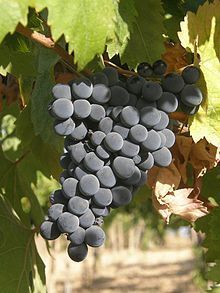
Despite the name, the grape called Montepulciano has nothing to do with the town of the same name in Toscana, nor does it have any relationship with the wine Vino Nobile di Montepulciano, which comes from Toscana. Rather, Montepulciano, the grape, is cultivated throughout Central Italy, from Le Marche to Apulia and most specifically in Abruzzo. Montepulciano is a varietal that makes a tremendously pleasing wine characterized by low acidity, manageable tannins, and a combination of the roundness of Merlot with the pepper and black fruit of Syrah. Known best for its DOC appellation Montepulciano d’Abruzzo, this varietal is said to have originated in Abruzzo, but it also appears in several other DOC wines throughout central Italy.
Montepulciano d’Abruzzo DOC, created in 1968, covers more or less the entire eastern half of its titular province. Despite the similarity in name, Montepulciano d’Abruzzo ought not be confused with Toscana’s Vino Nobile de Montepulciano, named for its nearest town, Montepulciano. Indigenous to Abruzzo, Montepulciano grows happily throughout the rugged terrain of central Italy, and the varietal forms the central component of this DOC and that of Le Marche’s Rosso Cònero, as well as serving as a recommended varietal for many others.
This grape possesses an extremely easy-going nature, thriving particularly well around the foothills of the Apennines near the town of Teramo, the site of its DOCG appellation, Montepulciano d’Abruzzo Colline Teramane. Although it suffers the reputation of being a little brother to some of the region’s better known wines, the medium-bodied, ruby-red, Montepulciano d’Abruzzo provides a very pleasant wine for a very good value. Lightly tannic but bouncy with acidity, this wine with a palate of berries and violets also has an intriguing spiciness that complements the region’s predilection for foods laced with hot peppers. The slightly sweet tannins of Montepulciano d’Abruzzo keep it lively in the bottle, but unchanged as it ages. Recent interest in playing with techniques in cultivation and vinification, however, may help make the genial Montepulciano d’Abruzzo become a more complex and burly wine in the future.
Montepulciano d’Abruzzo comes in four types. Vinified like a white with a short maceration on the skins, Cerasuolo is its rosé style, named for its bright cherry-red color. An unusually jaunty rosé, Cerasuolo can stand up to spicy foods; its DOC regulations allow for 85% Montepulciano and up to 15% of other local varietals, often Sangiovese. Montepulciano d’Abruzzo Rosso has the same grape allowances as the Cerasuolo, though it is vinified as a red with a longer maceration; this DOC also comes in a riserva form that requires 24 months of ageing. Montepulciano d’Abruzzo’s Casauria and Terre dei Vestini DOC types both require 100% Montepulciano, and both have riserva forms that require 24 months of ageing.
The best thing about Montepulciano d’Abbruzzo wines–other than their general deliciousness–is that they tend to be super affordable, offering a fresh, easy way to serve quality Italian wines any night of the week.
See on insideiwm.com
via Tumblr http://italianentertainment.tumblr.com/post/42506942701
